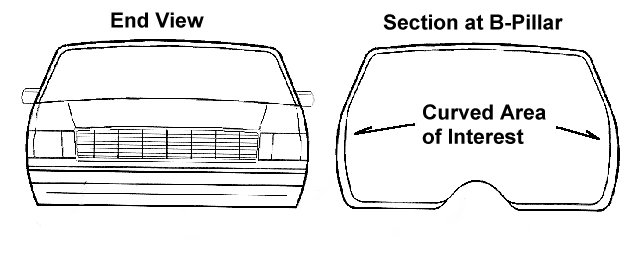
The Traffic Accident Reconstruction Origin -Approach Angles Solution-


The Traffic Accident Reconstruction Origin -Approach Angles Solution-
|

|
by Ed Phillips
Question 1: Did this damage occur in this collision?
Answer: Yes it did.
Question 2: What caused the damage to the interior of the car?
Answer: Imagine you are standing in front of the vehicle and staring back towards where the driver would be seated. If we could section the car in a plane which started at the drivers 'B' pillar and ended at the passenger 'B' pillar, the structural shape would be curved at the pillar areas.

Under the stress of the collision, when the occupants' bodies moved forward and stressed the webbing, they removed all the slack from the system. The tension between the anchoring points was great enough to demand even more belt to restrain the occupants. As the belts could not spool any further material due to the pawl locking, the belts were pulled tight between the retractor and the return loop. This tension took all the slack out of the curved storage sleeve and put pressure on the sleeve along the length of the belt between the retractor and return loop. This loading against the sleeve, over came the structural strength of the sleeve, and the belt pushed through, fracturing the sleeve. Essentially, the restraining forces on the belt were great enough to pull the webbing through the plastic sleeve. Conclusive evidence that the restraints were being worn during the crash against the fixed object.
It is easy to look at the exterior of a car and see that a large external force has slowed it in a very short time. We recognize this damage as a collision. In this case it was a collision with a tree. Less easily recognized is the observation that if the car stops suddenly, so must the occupants. This damage within the car is evidence of that occupant collision.
The position provides on-scene documentation through total station survey and photography of traffic collisions involving severe injuries and death. The entire County population is over 3 million residents, and the County maintains over 1,800 miles of roadways. Mr. Phillips has investigated hundreds of fatal collisions during his time with the County. He is used as a consultant for allied agencies, County Counsel and the District Attorneys' Office.
Mr. Phillips has consulted with Law Firms through out the western United States as well as the State Attorney Generals Office and the Department of Transportation.
Mr. Phillips holds Bachelor Degrees in Criminal Justice and Engineering (Manufacturing) and has attended many hundreds of hours of specific technical training in the field of collision reconstruction.
He can be contacted at Edphill@home.com
|
Copyright ©
|